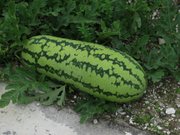By Gardener Jack
June is Poinciana month and a reminder that the royal Poinciana tree is one of the most extravagantly beautiful flowering trees of all. Bahamians are used to the exultant excess of flamboyance but visitors from the north are really impressed with the abundance of blossoms. Here on Abaco the rainy weather and windy conditions during much of May seems to have caused the local royal Poinciana trees to produce blossoms a little later than usual.
The rain caused by several different depressions has clouded the issue as to whether the real rainy season has begun. The real rainy season may well start in May but sometimes waits until June or July. When it arrives we can roll up our hoses because for a few months as rain will be irregular but plentiful.
An account of what I have being doing in my vegetable garden recently may help you decide what to do in your own. A couple of weeks ago I planted okra even though I do not care for it on a regular basis. I plan to pickle plenty of baby okras as I find they are enjoyed along with certain meals used in the same way as pickled cucumbers or gherkins.
A little later, after the new moon, I planted Crimson Sweet watermelons seeds. Crimson Sweet and Sugar Baby are the two favourite watermelon varieties in my family and both are very reliable producers. I was late planting watermelons this year but my vegetable gardens were filled with other crops. Now that tomatoes are not taking up much room I have the space for watermelons.
My real favourite summer crop is snake beans. I have the sprawling vines running on porch railings and also being trained onto mango trees. When the beans produce it is best to pick them at about ten inches, though they will grow to over two feet. I like to cut them into two-inch sections and stir fry them in sesame oil, along with garlic.
In one plot I have tomatillo plants up to full size and beneath them I am growing bell peppers. The peppers enjoy warm weather conditions but need some protection from the sun to avoid scalding of the fruits. The tomatillo plants are much taller than the pepper plants so provide them with sufficient shade. In the same area I am growing eggplants, another hot weather lover.
My last crop of sweet corn was harvested in May and I am still undecided whether to plant any more. If I do it will be in mid-June. Corn needs a lot of protection against insect predation and the hotter it is, the greater the threat.
The flowers of summer - zinnias, cosmos, vincas and the other usual suspects - are already in their element. If you have not gotten around to planting summer flowers from seed you can buy them in the form of seedlings in flats. Marigolds grow so quickly from seed you can have flowers by late July from seeds sown now.
Barbados cherry, Surinam cherry, wax jambu and early mangoes are the main fruits of June. All fruit trees should be fertilized at least three times a year and summer is the most important season.
Prepare your fruit and citrus trees by drenching the base of each with five gallons of water with a teaspoon or two of Sequestrene 138 chelated iron added and dissolved. The Sequestrene 138 provides iron for the tree but also acts as a catalyst for the other elements that may otherwise become tied up in our calcareous soil.
Granular fruit and citrus special should then be applied around the base of the tree and along the drip line. Water the area well before applying fertilizer if conditions are dry. To complete the operation, spray the trees with a minor nutrients or elements solution, using a sticker/spreader added to the solution in a hose end sprayer. Citrus trees in particular have shiny leaves and a sticker/spreader helps the spray stay on the leaves instead of sheeting off. Use a little dish washing liquid or liquid soap if commercial sticker/spreader is not available.
gardenerjack@coralwave.com





Comments
Use the comment form below to begin a discussion about this content.
Sign in to comment
Or login with:
OpenID